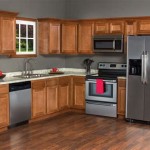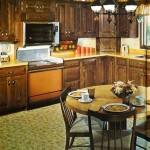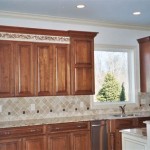Automated Kitchen Cabinets: A Paradigm Shift in Kitchen Design
The kitchen, traditionally considered the heart of the home, is undergoing a technological revolution. Automation, once relegated to science fiction, is now permeating every facet of modern living, and the kitchen is no exception. One particularly compelling innovation lies in automated kitchen cabinets. These intelligent storage solutions are redefining kitchen design, convenience, and accessibility, moving beyond the static functionality of their conventional counterparts. This article explores the features, benefits, and implications of automated kitchen cabinets, providing a comprehensive overview of this emerging technology.
Automated kitchen cabinets represent a significant departure from traditional cabinetry. They are characterized by the integration of electronic components, motorized mechanisms, and smart technology features. This allows for hands-free operation, customizable configurations, and enhanced accessibility for individuals of all ages and abilities. Unlike static cabinets, automated systems offer dynamic adjustability, adapting to the user's needs and preferences through programmable settings and sensor-driven responses.
Key Features of Automated Kitchen Cabinets
Automated kitchen cabinets encompass a range of technological advancements that collectively contribute to a more efficient and user-friendly kitchen environment. These features extend beyond basic opening and closing mechanisms, encompassing advanced functionality designed to optimize storage and accessibility.
Motorized Operation: The core of any automated cabinet system is its motorized mechanism. This typically involves electric motors, actuators, and control systems that facilitate the smooth and silent opening and closing of cabinet doors and drawers. These motors are designed for durability and reliability, capable of handling repeated use over extended periods. Sophisticated control systems ensure precise movement and prevent damage to the cabinet or its contents. In many systems, the speed and force of operation are adjustable, allowing users to tailor the performance to their specific needs.
Touchless Activation: Many automated kitchen cabinet systems feature touchless activation through the use of sensors. These sensors, often employing infrared or motion-detection technology, allow users to open and close cabinets with a simple wave of the hand or foot. This is particularly beneficial when hands are occupied or dirty, preventing the spread of germs and maintaining a hygienic kitchen environment. The sensitivity of these sensors is adjustable, preventing accidental activation and ensuring precise control.
Voice Control Integration: In line with the growing trend of smart home integration, many automated kitchen cabinet systems are compatible with voice control platforms like Amazon Alexa and Google Assistant. This allows users to operate cabinets hands-free simply by issuing voice commands. For instance, a user can say, "Alexa, open the spice cabinet," or, "Google, close the pantry door." This feature enhances convenience and accessibility, particularly for individuals with mobility limitations.
Programmable Presets: Automated kitchen cabinets often incorporate programmable presets, allowing users to customize cabinet configurations and access specific items with ease. These presets can be programmed to adjust shelf heights, drawer depths, and lighting levels to suit individual preferences. For example, a user might create a preset for "breakfast preparation," which automatically opens cabinets containing frequently used items like coffee, cereal, and utensils. This level of customization streamlines kitchen tasks and enhances efficiency.
Automatic Lighting: Integrated lighting systems are a common feature in automated kitchen cabinets. These systems typically employ LED lights that illuminate the cabinet interior when opened, providing enhanced visibility and making it easier to locate items. The lighting can be programmed to adjust brightness and color temperature to suit the user's preferences. Some systems even incorporate motion-activated lighting that automatically turns on when someone approaches the cabinet, providing hands-free illumination.
Obstruction Detection: Safety is a paramount concern in automated systems. Automated kitchen cabinets are equipped with obstruction detection technology that prevents them from closing if an object is in the way. This technology typically relies on sensors that detect resistance or changes in pressure. If an obstruction is detected, the cabinet will automatically stop and reverse direction, preventing injury or damage. This feature is particularly important in households with children or pets.
Smart Storage Solutions: Beyond basic opening and closing mechanisms, automated kitchen cabinets can incorporate smart storage solutions that optimize space utilization and organization. These solutions might include automated shelving systems that adjust to accommodate items of different sizes, or automated drawer organizers that keep utensils and cookware neatly arranged. These features maximize storage capacity and make it easier to find and retrieve items.
Remote Monitoring and Control: Some advanced automated kitchen cabinet systems offer remote monitoring and control capabilities through smartphone apps or web interfaces. This allows users to monitor cabinet status, adjust settings, and even open or close cabinets remotely. This feature can be particularly useful for individuals with mobility limitations or for caregivers who need to assist elderly or disabled family members.
Benefits of Automated Kitchen Cabinets
The integration of automation into kitchen cabinetry offers a multitude of benefits, transforming the kitchen into a more efficient, accessible, and user-friendly space. These benefits extend beyond mere convenience, impacting accessibility, safety, and overall kitchen design.
Enhanced Accessibility: One of the most significant benefits of automated kitchen cabinets is enhanced accessibility for individuals with mobility limitations. Motorized operation and touchless activation make it easier for people with arthritis, limited reach, or other physical challenges to access stored items. Programmable presets and voice control further enhance accessibility by allowing users to customize cabinet configurations and operate them hands-free. This technology empowers individuals to maintain independence and participate more fully in kitchen activities.
Increased Convenience: Automated kitchen cabinets streamline kitchen tasks and enhance convenience. Hands-free operation allows users to access items even when their hands are full or dirty. Programmable presets automate repetitive tasks, such as opening specific cabinets for meal preparation. These features save time and effort, making kitchen tasks more efficient and enjoyable. The convenience offered by automated cabinets is particularly valuable in busy households and for individuals who value efficiency.
Improved Kitchen Hygiene: Touchless activation helps to maintain a hygienic kitchen environment by reducing the spread of germs and bacteria. Users can open and close cabinets without touching handles or surfaces, minimizing the risk of contamination. This is particularly important in households with young children or individuals with compromised immune systems. By promoting hygiene, automated kitchen cabinets contribute to a healthier living environment.
Optimized Storage and Organization: Automated kitchen cabinets can incorporate smart storage solutions that optimize space utilization and organization. Automated shelving systems and drawer organizers maximize storage capacity and make it easier to find and retrieve items. This can be particularly beneficial in small kitchens where space is limited. By promoting organization, automated cabinets help to create a more efficient and clutter-free kitchen environment.
Enhanced Safety: Obstruction detection technology prevents automated kitchen cabinets from closing if an object is in the way, preventing injury or damage. This feature is particularly important in households with children or pets. Remote monitoring and control capabilities allow caregivers to monitor cabinet status and assist elderly or disabled family members, enhancing safety and providing peace of mind. The safety features of automated cabinets contribute to a more secure and user-friendly kitchen environment.
Modernized Kitchen Design: Automated kitchen cabinets contribute to a sleek and modern kitchen aesthetic. Clean lines, integrated lighting, and touchless operation create a visually appealing and technologically advanced space. The ability to customize cabinet configurations and finishes allows users to create a kitchen that reflects their personal style and preferences. By enhancing the visual appeal of the kitchen, automated cabinets add value to the home and create a more enjoyable living environment.
Considerations for Implementing Automated Kitchen Cabinets
While the benefits of automated kitchen cabinets are numerous, it is important to consider certain factors before implementing these systems. These considerations encompass installation requirements, cost implications, and maintenance needs.
Installation Requirements: Installing automated kitchen cabinets typically requires professional expertise. The installation process involves integrating electronic components, wiring motors, and configuring control systems. It is important to choose a qualified installer who has experience with automated cabinet systems. Proper installation is essential to ensure that the system functions correctly and safely. Existing cabinetry may require modification or replacement to accommodate automated components, adding to the complexity and cost of installation.
Cost Implications: Automated kitchen cabinets are generally more expensive than traditional cabinets due to the integration of electronic components and motorized mechanisms. The cost can vary depending on the complexity of the system, the number of cabinets being automated, and the level of customization. It is important to factor in both the initial purchase cost and the installation cost when budgeting for automated kitchen cabinets. While the initial investment may be higher, the long-term benefits of enhanced accessibility, convenience, and efficiency may justify the expense.
Maintenance Needs: Automated kitchen cabinets require regular maintenance to ensure optimal performance. This may involve cleaning sensors, lubricating moving parts, and replacing batteries or motors as needed. It is important to follow the manufacturer's instructions for maintenance and to address any issues promptly to prevent further damage. While automated systems are designed for durability, electronic components are susceptible to wear and tear over time. Regular maintenance can extend the lifespan of the system and minimize the need for costly repairs.
Power Requirements: Automated kitchen cabinets require a reliable power source to operate. This typically involves connecting the system to the home's electrical grid or using battery-powered systems. It is important to ensure that the power supply is adequate to handle the electrical load of the automated components. Battery-powered systems require periodic battery replacement, which adds to the maintenance requirements. In the event of a power outage, some automated systems may revert to manual operation, while others may become temporarily inoperable.
Compatibility with Existing Kitchen Design: When considering automated kitchen cabinets, it is important to assess their compatibility with the existing kitchen design. The style, materials, and finishes of the automated cabinets should complement the overall aesthetic of the kitchen. It may be necessary to make modifications to existing cabinetry or appliances to accommodate the automated components. Careful planning and design are essential to ensure that the automated cabinets seamlessly integrate into the kitchen environment.
Security Considerations: Automated kitchen cabinet systems that are connected to the internet may be vulnerable to security breaches. It is important to take steps to protect the system from unauthorized access, such as using strong passwords, enabling two-factor authentication, and keeping the software up to date. Consider the privacy implications of collecting and storing data about cabinet usage. Implementing robust security measures can help to mitigate these risks and ensure the privacy and security of the system.

Automation For Multifunctional Kitchens

Modern Modular Plywood Kitchen Cabinets Wood Buffet Automated Sink Base Unit Corner Cabinet Storage Made In China Com

Motorized Automatic Verical Lift Wall Kitchen Cabinet Doors Design Craft

Handsfree Automatic Kitchen Cabinets Types What To Know

Customized Aluminum Cupboard Automated Organization Expandable Kitchen Cabinets Cabinet Made In China Com
340 000 Moley Robotic Kitchen Is Ready To Make You Dinner

Handleless Kitchen Cabinets For Modern Homes 2025 Guide

Motorized Automatic Verical Lift Wall Kitchen Cabinet Doors Design Craft

Get Those Upper Shelves In Reach Scio Community

Opening Mechanism For Push To Open Cabinet Door Decora
Related Posts








